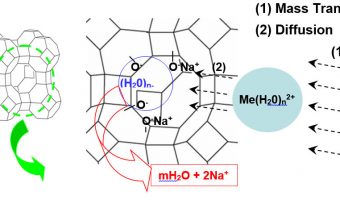Silver nanoparticles are small-sized particles of silver that are in the range of 1 and 100 nm in size. Silver nanoparticles pose unique features which help in diagnosis, treatment, drug delivery, as well as in medical devices that are used in several biomedical but environmental applications also. The review presents that the most important methods […]
Category: AMTE
Mohamed Gomaa ABO-GABIEN, Ahmed Rezk ATAWIA, Hamed El-ZAABALAWY Mahmoud El-BADAWY, Sherif Fathy El-GIOUSHY, Saber Mahmoud BAKEER; Soil remediation for improving the growth of “Aggizi” olive trees under salt stress conditions; Advanced Materials and Technologies Environmental Sciences; 2021:5(1): 320-336
Olive is a traditionally important crop grown in South Sinai, where soil and water salinization may occur. The use of soil remediation approaches may improve the tolerance of plants to salt stress. The present study focuses on the soil application of magnetic iron (MI) and/or potassium humate (KH) to “Aggizi” olive trees. Ten-year-old trees grown […]
Nandini Priyam RAJKUMARI, Gayatri SAIKIA, Pallabi GOSWAMI; Physicochemical studies of ZnO and TiO2 semiconductors and their photocatalytic behaviour towards UV and visible light active drug and dye degradation; Advanced Materials and Technologies Environmental Sciences; 2020:4(3): 308-319
Metal oxide semiconductors are of great technological importance in environmental remediation because they can generate charge carriers when stimulated with the required energy. ZnO and TiO2, both well-known photocatalysts, were taken into account for our study because of their practical, inexpensive, non-toxic behavior, high photosensitivity, stability, and increased activity towards photocatalytic degradation of organic pollutants. […]
Noemi BEVILACQUA, Massimo MORASSUT, Maria Cecilia SERRA, Francesca CECCHINI; The role of grapevine training system on carbon dioxide emission: a case study; Advanced Materials and Technologies Environmental Sciences; 2020:4(1): 298-307
Wine sector is very important agri-food branch and represent a relevant segment of the worldwide economy. Several studies have evaluated the environmental profile of grape and wine production using life cycle assessment (LCA). During viticulture practices and wine production a considerable quantity of residues is generated: woody waste from pruning process, stalks from de-stemmed grapes, […]
Abdel BOUGHRIET, Nicole POUMAYE, Oscar ALLAHDIN, Michel WARTEL; Kinetic and diffusional aspects of heavy metals adsorption onto zeolitized brick; Advanced Materials and Technologies Environmental Sciences; 2019:3(4): 281-297
A kinetic study of the removal of Cd2+, Co2+, Fe2+, Mn2+, Ni2+, Pb2+ and Zn2+ cations from single component solution by zeolitized brick was undertaken at 298 K under batch conditions. Kinetic data were well explained by a pseudo-second-order rate model. Correlation analysis showed that the metal affinity sequence of the activated brick followed the […]
Ali MAGHSOUDIAN, Mohammad SHAJIRAT, Shahin KORD, Yousef TAMSILIAN, Shohreh VOSOUGHI; Polymer flooding as one of the most promising technologies in enhanced oil recovery: an updated review; Advanced Materials and Technologies Environmental Sciences; 2019:3(2): 255-280
Polymer flooding is an excellent candidate for enhancing recovery factor through increasing volumetric sweep efficiency. Polymers are generally used to increase the viscosity of the displacing fluid. These chemicals significantly reduce the mobility ratio between the displacing and displaced fluid. This paper aims to provide a comprehensive review about enhanced oil recovery (EOR) methods, pros […]
Valerii BARBASH, Olha YASHCHENKO. Developing the technology of obtaining microcrystalline cellulose from flax fibers; Advanced Materials and Technologies Environmental Sciences; 2019:3(2): 247-254
The process of obtaining microcrystalline cellulose from flax fibers, which involves obtaining organosolv pulp in an environmentally safer method, followed by its treatment with a mixture of acids and hydrolysis, is explored. The proposed technology allows reducing the number of stages of processing plant materials, eliminating the use of more expensive chemicals and reducing the […]
Razieh AHMADI, Shahriar OSFOURI, Reza AZIN; Optimization of Factors Affecting Oil Recovery During Water Flooding by DE Algorithm; Advanced Materials and Technologies Environmental Sciences; 2019:3(1): 235-246
In the recent years, the application of nanotechnology for the upstream petroleum has got enormous research attention. The goal of this paper is to focus on the effect of injection rate of water, nanofluid concentration, and particle size of nanoparticles on oil recovery factor during nanofluid injection into oil reservoir. A mathematical model and numerical […]
Angela SPOIALA, Denisa FICAI, Oguzhan GUNDUZ, Anton FICAI, Ecaterina ANDRONESCU; Silver nanoparticles used for water purification; Advanced Materials and Technologies Environmental Sciences; 2018:2(4): 220-234
Currently, world population is 7,62 billion people and thus the need for safe, clean water is imperious. World Health Organization/ UNICEF carried-out studies that almost 1,5 billion people are in danger because they do not have access to safe potable drinking water and nearly 3 billon people lack access to clean water. Studies suggest that […]
Hamdy Maamoun ABDEL-GHAFAR, El-Sayed ALI ABDEL-AAL and Mohamed Mohamed SHOUKRY; Adsorption Characteristics of Na+ Ions onto Ion Exchange Resin: Kinetics and Isotherms; Advanced Materials and Technologies Environmental Sciences; 2018:2(2): 206-219
The adsorption of sodium ions onto Amberjet 1500H synthetic ion exchange resin was studied. The study was conducted by a batch method to determine equilibrium and kinetic studies using synthetic solution of 5.3 pH and Na concentration ranged from 10 to 20 mg/L. The experimental isotherm data were analyzed using Temkin and Dubinin-Radushkevich equations. Adsorption […]

